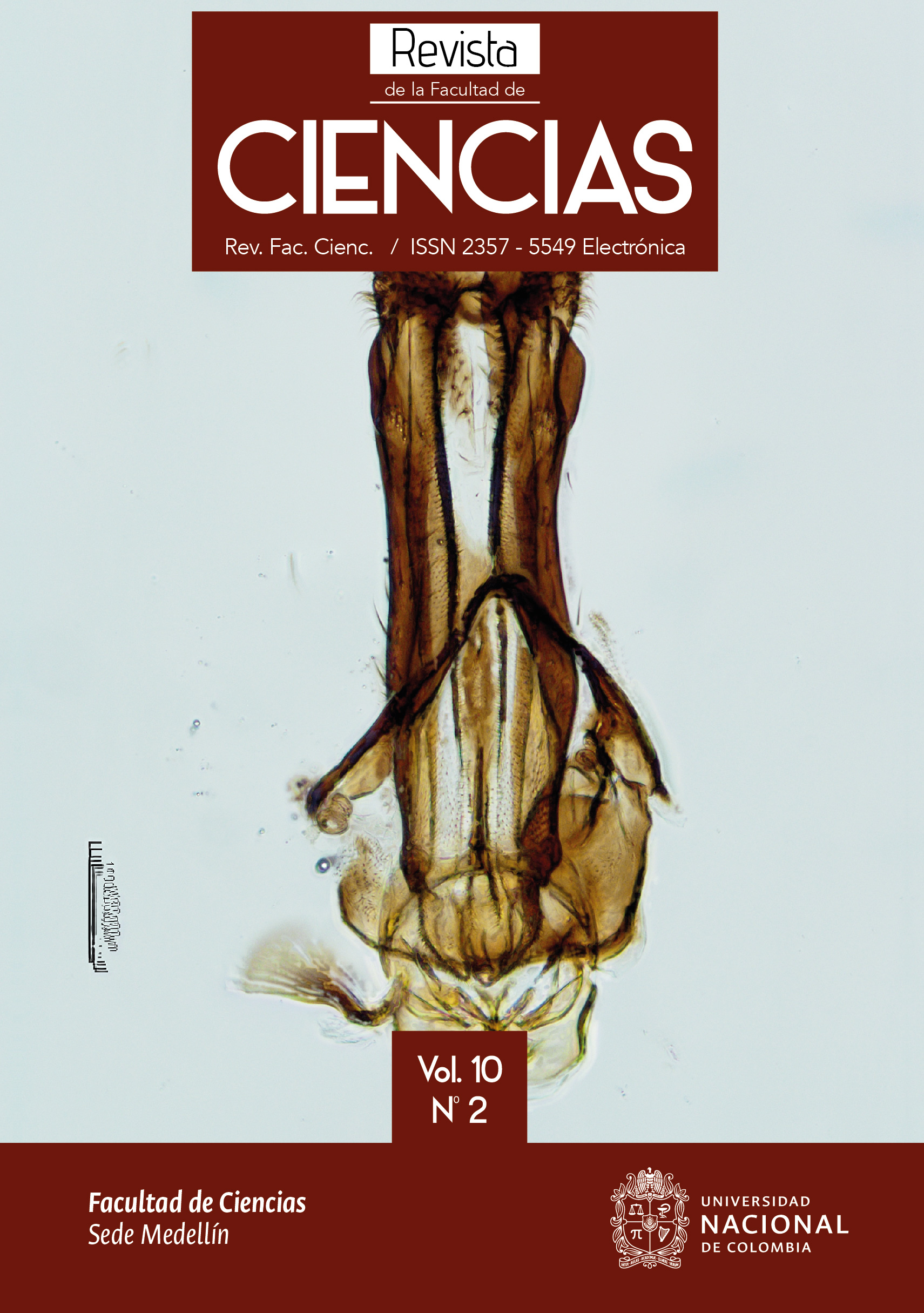MODELOS DE CONTEO ALTERNATIVOS PARA LOS COMPONENTES DEL CPO EN UNA ENCUESTA DE SALUD BUCAL EN MONTEVIDEO, URUGUAY
ALTERNATIVE COUNTING MODELS FOR DFM COMPONENTS IN AN ORAL HEALTH SURVEY IN MONTEVIDEO, URUGUAY
DOI:
https://doi.org/10.15446/rev.fac.cienc.v10n2.80743Palabras clave:
CPO, modelos de conteo, modelos hurdle, modelos de Poisson, sobredispersión. (es)Count models, DMF, hurdle models, overdispersion, Poisson models (en)
Descargas
Actualmente existen varios indicadores de las diferentes dimensiones que se determinan a nivel individual en salud oral desde una perspectiva epidemiológica. Dentro de los que corresponden a la patología Caries se consideran entonces los indicadores CPO, ceo, ICDAS entre otros. El CPO es un índice unidimensional que cuenta el número de dientes cariados C, perdidos P y obturados O y cuando debe ser evaluado en un contexto de regresión, es un caso particular de Modelo de Conteo, donde la variable de respuesta refiere al número de veces que un evento ocurre, siendo el evento de conteo la realización de una variable aleatoria no negativa, pudiéndose trabajar con el marco conceptual de la teoría de los Modelos Lineales Generalizados (MLG). En la revisión de la literatura en varios trabajos publicados en revista especializadas de Biomedicina y Epidemiología bien rankeadas no se le presta mucha atención a estos aspectos, donde no queda muchas veces claro porque se opta por alternativas al modelo de Poisson, sino que tampoco se trabaja la capacidad de ajuste (ver capacidad predictiva). Los autores muchas veces solamente se dedican a ver las variables y ajustar modelos, resolviéndose por aquellos donde aparecen variables significativas pero que podrían ser muy pobres prediciendo. Este último aspecto es relevante ya que en base a esos modelos los investigadores terminan elaborando teoría para explicar patologías en función de variables que no son buenas predictoras. Por estos motivos en este trabajo se presentan alternativas a los modelos de conteo básicos y se pone un especial énfasis en la capacidad predictiva de los mismos.
Currently, there are several indicators of the different dimensions that are determined at the individual level in oral health from an epidemiological perspective. Among those that correspond to the Caries pathology, the DFM, ceo, ICDAS indicators are considered. DFM is a one-dimensional index that counts the number of teeth decayed D, filled F, missing M and when it should be evaluated in a regression context, is a particular case of a counting model, where the response variable refers to the number of times an event occurs; this counting event is the realization of a non-negative random variable, being able to work with the conceptual framework of the theory of the Generalized Linear Models (GLM). In the review of the literature in several papers published in well-ranked specialized journals of Biomedicine and Epidemiology, little attention is paid to these aspects,where it is not often clear why the authors opt for alternatives to the Poisson model, and they do not work on the adjustment capacity either. Authors often only look at the variables and adjust models, resolving themselves by those where significant variables appear but which could be very poor predicting. This last aspect is relevant since based on these models the researchers then in the discussion end up elaborating theory to explain pathologies based on variables that are not good predictors.
Referencias
Keizer, J. J.; Ferreira, A. J. D.; Coelho, C. O. A.; Doerr, S. H.; Malvar, M. C.; Domingues, C. S.P.; Perez, I. M. B.; Ruiz, C.; Ferrari, K. (2005). The role of tree stem proximity in the spatial variability of soil water repellency in a eucalypt plantation in coastal Portugal. Aust. J. SoilRes. 43: 251-259. DOI: https://doi.org/10.1071/SR04096
Breilh, J. (2010). La epidemiologı́a crı́tica: una nueva forma de mirar la salud en el espacio urbano.Salud Colectiva, 31: 152-157. DOI: https://doi.org/10.18294/sc.2010.359
Cameron, A. (1998).Regression analysis of count data. Cambridge University Press. Cambridge,UK New York. NY. USA. DOI: https://doi.org/10.1017/CBO9780511814365
Fejerscov, O. (2004). Changing paradigms in concept son dental caries: Consequences for oral health care. Caries Research, 38: 182-191. DOI: https://doi.org/10.1159/000077753
Giner, G. y Smyth, G. K. (2016).statmod: probability calculations for the inverse gaussian distribution. R Journal, 8(1): 339–351. DOI: https://doi.org/10.32614/RJ-2016-024
Hilbe, J. (2011). Negative binomial regression. Cambridge University Press. New York. DOI: https://doi.org/10.1017/CBO9780511973420
Hilbe, J. (2014). Modeling count data. Cambridge University Press, New York, NY. DOI: https://doi.org/10.1017/CBO9781139236065
Hilbe, J. M. (2016).COUNT: Functions, Data and Code for Count Data. R package version 1.3.4.aushal S, Patnaik VVG, Agnihotri G (2003). Mandibular Canines In Sex Determination J Anat.Soc. India; 52(2) 119-124. ?Sassi C, Picapedra A, Lima L,
Francesquini Jr L, Daruge E, Daruge Jr E (2012). Sex determination in Uruguayans by odontometric analysis Braz J Oral Sci; 11(3):381-386
Holst, D., Schuller, A., Aleksejuniené, J., y EriKsen, H. (2001). Caries in populations a teorical,casual approach. European Journal Of Oral Science 109(3): 143-148. DOI: https://doi.org/10.1034/j.1600-0722.2001.00022.x
Maltz, M. y Jardim, J. Alves, L. (2010). Health promotion and caries dental caries. Braz. Oral Res.24(Spec Iss 1): 18-25. DOI: https://doi.org/10.1590/S1806-83242010000500004
Mullahy, J. (1986).Specification and testing of some modified count data models. Journal of Econometrics. 33: 341-365 DOI: https://doi.org/10.1016/0304-4076(86)90002-3
Peterson, P. (2004). Challenges to improvement of oral health in the 21st century - the approach of the who global oral health programme. International Dental Journal, 54: 329-343. DOI: https://doi.org/10.1111/j.1875-595X.2004.tb00009.x
R Core Team (2016).A Language and Environment for Statistical Computing. R Foundation for Statistical Computing, Vienna, Austria.
Rigby, R. A. y Stasinopoulos, D. M. (2005). Generalized additive models for location, scale and shape,(with discussion). Applied Statistics 54: 507-554. DOI: https://doi.org/10.1111/j.1467-9876.2005.00510.x
Venables, W. N. y Ripley, B. D. (2002). Modern Applied Statistics with S. Springer-Verlag, New York, 4a edición. DOI: https://doi.org/10.1007/978-0-387-21706-2
Wheeler, B. (2016).SuppDists: Supplementary Distributions. R package version 1.1-9.4.
Cómo citar
APA
ACM
ACS
ABNT
Chicago
Harvard
IEEE
MLA
Turabian
Vancouver
Descargar cita
Licencia
Derechos de autor 2021 Revista de la Facultad de Ciencias

Esta obra está bajo una licencia internacional Creative Commons Atribución-NoComercial-SinDerivadas 4.0.
Los autores o titulares del derecho de autor de cada artículo confieren a la Revista de la Facultad de Ciencias de la Universidad Nacional de Colombia una autorización no exclusiva, limitada y gratuita sobre el artículo que una vez evaluado y aprobado se envía para su posterior publicación ajustándose a las siguientes características:
1. Se remite la versión corregida de acuerdo con las sugerencias de los evaluadores y se aclara que el artículo mencionado se trata de un documento inédito sobre el que se tienen los derechos que se autorizan y se asume total responsabilidad por el contenido de su obra ante la Revista de la Facultad de Ciencias, la Universidad Nacional de Colombia y ante terceros.
2. La autorización conferida a la revista estará vigente a partir de la fecha en que se incluye en el volumen y número respectivo de la Revista de la Facultad de Ciencias en el Sistema Open Journal Systems y en la página principal de la revista (https://revistas.unal.edu.co/index.php/rfc/index), así como en las diferentes bases e índices de datos en que se encuentra indexada la publicación.
3. Los autores autorizan a la Revista de la Facultad de Ciencias de la Universidad Nacional de Colombia para publicar el documento en el formato en que sea requerido (impreso, digital, electrónico o cualquier otro conocido o por conocer) y autorizan a la Revista de la Facultad de Ciencias para incluir la obra en los índices y buscadores que estimen necesarios para promover su difusión.
4. Los autores aceptan que la autorización se hace a título gratuito, por lo tanto renuncian a recibir emolumento alguno por la publicación, distribución, comunicación pública y cualquier otro uso que se haga en los términos de la presente autorización.
5. Todos los contenidos de la Revista de la Facultad de Ciencias, están publicados bajo la Licencia Creative Commons Atribución – No comercial – Sin Derivar 4.0.
MODELO DE CARTA DE PRESENTACIÓN y CESIÓN DE DERECHOS DE AUTOR






















